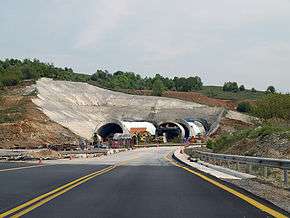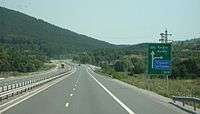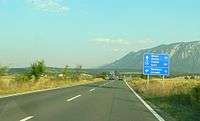European route E79
| |
|---|---|
 | |
| Route information | |
| Length: | 1,300 km (800 mi) |
| Major junctions | |
| North end: | Miskolc (Hungary) |
| South end: | Thessaloniki (Greece) |
| Location | |
| Countries: | Hungary, Romania, Bulgaria, Greece |
| Highway system | |
| International E-road network | |



European route E 79 is a road part of the International E-road network. It begins in Miskolc, Hungary and ends in Thessaloniki, Greece, also running through Romania and Bulgaria. The road is 1,300 km (810 mi) long.
Route overview
The road follows the route:
| Country | Route | Designations |
|---|---|---|
| |
Miskolc – Debrecen – Berettyóújfalu | |
| |
Oradea – Beiuș – Deva – Petroșani – Târgu Jiu – Craiova – Calafat | |
| |
Vidin – Vratsa – Botevgrad – Sofia – Pernik – Blagoevgrad – Kulata | |
| |
Promachonas – Serres – Thessaloniki | |
Route description
Hungary
The Hungarian section of E79 shares parts of its path with other E-roads, such as E60, E573 and E71.[1]
Romania
The Romanian section of the road is mostly under construction, as can be seen on the map with Romanian road quality.[2] Although only in the region of 500 km (310 mi) the road itself is single carriageway except in major towns. With little or no room for overtaking, a 50 km/h (31 mph) restriction when passing through the many minor villages, and a great number of slow vehicles, the average speed is generally in the low 50 km/h range.
Since 2007, the year of Romania's accession to the European Union, work has begun to improve the quality of this road:
- Oradea – Deva [bad, under construction]: The road is under construction. Expect bumps in the road, traffic lights and delays. As of the 25 August the Oradea to Deva road is very bad with the last part Brad to Deva impassable for most vehicles. It requires an over 120 km detour which is not marked but is a very picturesque drive through mountains and many hairpins. This should not be designated an E road until repairs are completed as there are (we are told) much better routes. The repairs involve, at least, 20 long single lane traffic light controlled sections which are very slow indeed. Do NOT drive on this route. Repairs are underway slowly and should be scaled up.
A contract was signed on 30 January 2012 to improve this section, with the joint venture CCCF Drumuri și Poduri Timișoara–CO.GE.FA S.p.A.–Simco SRL. Contract value: 36.6 million euro. Financing sources: 50% from the state budget, 50% loaned from the European Investment Bank. Works on this section began, as of August 2012.[3] The rehabilitation of this section of the road was expected to be finished by the end of 2014.[4] In December 2014, more than 60% of this section was still under construction (expected to continue until autumn-winter 2015). On the 4th of December 2013, the Romanian Ministry for European Funds sent to the European Commission a request to evaluate the financing of this sector, for a total of 210 million Euro (of which 142 million Euro from the EU through the ERDF mechanism).[5]
- Deva – Petroșani [good, done]: The road has been significantly improved in the last years, being widened and having excellent asphalt quality on the entire section of the road (construction finished in 2012).
- Petroșani – Bumbești Jiu [average, under construction]: This section should be considered as an under construction. Conditions have partially improved in late 2015 [6] (due to rehabilitation work done by Copisa Constructora Pirenaica–Chirulli Andrea Impresa Individuale–Coremi Inter joint venture - 34 mil. euro contract, signed in 29 June 2012). The southern half of the route is in good condition (good asphalt, traffic signs, jersey blocks to block possible fall into the valley). The north half is mostly 1st layer of asphalt. While the road looks and feels much better compared to previous years, there may still be traffic lights and work on the road starting in the spring of 2016 (during the winter all work is stopped). Works on this section were expected to take around two years, and were expected to be finished by the end of 2014. In December 2015, the section was still under construction on about 50% of its length, and should be considered as such until summer-autumn 2016. On the 29th of November 2013, the Romanian Ministry for European Funds sent to the European Commission a request to evaluate the financing of this sector, for a total of 396 million Euro (of which 288 eligible for EU funds, of which 244 million Euro from the EU through the ERDF mechanism).[7]
- Bumbești Jiu – Craiova [good, minor construction work]: The section Bumbești Jiu – Rovinari is in good condition, almost completely rehabilitated (rehabilitation work by Asocierea Comsa S.A.U. - Corporate Management Solution SRL, 117 mil. RON, 85% FEDR + 15% National funds, 90% done in January 2016 according to the national roads company [8]). The section Rovinari - Filiasi has been repaired in 2010, by FCC Construccion, and is currently in good condition. The section Filiași – Craiova is part of the DN6 road and is in good condition, also being repaired in 2010.
- Craiova – Calafat [under construction]: This section is currently under construction, and will be so until the end of 2016. In September 2015, the parts of the road closer to Craiova already had asphalt, while parts closer to the Danube were in various stages of construction.[9] On the 6th of December 2013, the Romanian Ministry for European Funds sent to the European Commission a request to evaluate the financing of this sector, for a total of 73 million Euro (of which 47 million Euro from the EU through the ERDF mechanism).[10]
Bulgaria
The Bulgarian section of E79 spans nearly 400 km (250 mi) from the North Bulgarian city of Vidin, connecting the Calafat–Vidin Bridge (or, alternatively, the Vidin-Calafat ferry line) across the Danube River and straight southwards towards Bulgaria's capital Sofia. The road has moderately good surface, it is constantly maintained and repaired and well signed with directing signs in Bulgarian and in English. Most of the length from Vidin to Botevgrad, the road is two-lane tarmac road following the natural relief of the landscape. There are sections where 3 lanes for overtaking slow-moving traffic are available. Rest stops and parking spots near the road are also available. The Bulgarian Traffic law prescribes a 50 km/h (31 mph) in most residential areas coinciding with the route of the road and not more than 90 km/h (56 mph) on the section of the road outside living areas. There are plans to upgrade Vidin-Botevgrad road to a grade separated expressway (close to motorway standard), allowing speeds up to 140 km/h (87 mph).
From Botevgrad to Sofia, E79 joins Hemus motorway, designated A2. At the Bulgarian capital Sofia you have to enter the Ring Road, until Sofia Northern Bypass motorway is built. Signage is available. From Sofia to south there are 52 km (32 mi) of motorways (A6 Lyulin motorway and A3 Struma motorway) to Dupnitsa-north interchange. The Bulgarian Traffic law allows speeds up to 140 km/h (87 mph) on motorways. Higher speed should not be attempted. The road is leading from Dolna Dikanya to south, right to the Kulata-Promachonas. All the way to the Border Check point the road is of the standard 2-lane tarmac except for the section from the Pernik Province-Blagoevgrad Province border and the southern entrance to the city of Blagoevgrad where the road is of highway type and is 8 km (5.0 mi) long. The remaining section from Dupnitsa to the border with Greece is to be upgraded to a motorway with planning being in the final phase. The section between Dupnitsa and Blagoevgrad, 37 km long, also is in construction and is scheduled to be completed in 2015. Also the last of these sections - lot 4 from Sandanski-south to the Greek border of 13 km opened to traffic in August 2015. The stretch between Blagoevgrad and Sandanski - lot 3 - passes through the Kresna Gorge and is planned to feature a 13.3 km (8.3 mi) tunnel, which will be the longest motorway tunnel in Eastern Europe, whose construction will begin in 2015 and will cost app. EUR 650 mln.
There are no restriction to trucks driving in the weekends (except when temps rise above 38 °C (100 °F)) so they pose additional road hazard particularly high when driving at night. Traffic is usually heavy in weekends and overtaking has to be done swiftly and without risk, minding the other participants in the traffic.
At night, motorcyclists are required (and that is strongly advisable for their own safety) to use high-visibility vests.
Greece
The Greek Section of E79 has a length of about 120 km (75 mi). After crossing the Bulgarian-Greek border entering into Greece, the road drastically improves as it has been upgraded to a motorway; and speeds of up to 120 km/h (75 mph) are common. After the Promachonas Border Checkpoint, there is a section in construction, about 20–30 km. After that the new 3 lane motorway is well managed, repaired and policed up to the city of Loutra Serron. Construction and upgrading works are still continuing near Serres (due to state budget cuts, works are not scheduled to complete before 2015). After Serres the 3 lane motorway continues for a further 60 km (37 mi) and finally ends at a large junction with the A2/E90, which then provides direct access with Thessaloniki's Ring Road motorway and onto Chalkidiki, for travellers heading south.
References
- ↑ http://www.unece.org/fileadmin/DAM/trans/conventn/ECE-TRANS-SC1-384e.pdf
- ↑ http://forum.peundemerg.ro/index.php?topic=199.0
- ↑ http://www.bihon.ro/copaci-doborati-pentru-largirea-dn76/1160798
- ↑ http://www.zf.ro/companii/constructii/topul-celor-mai-mari-contracte-de-infrastructura-in-primele-sase-luni-compania-de-drumuri-nu-a-dat-niciun-contract-de-autostrazi-9915383
- ↑ http://www.fonduri-ue.ro/comunicare/stiri-am-oi/2289-pos-t
- ↑ http://forum.peundemerg.ro/index.php?topic=12.3015
- ↑ http://www.fonduri-ue.ro/comunicare/stiri-am-oi/2220-pos-t
- ↑ http://cnadnr.ro/img/tabel/STADIULPROIECTELORINDERULARE.pdf
- ↑ http://forum.peundemerg.ro/index.php?topic=12.msg88616#msg88616
- ↑ http://www.fonduri-ue.ro/comunicare/stiri-am-oi/2287-pos-t

